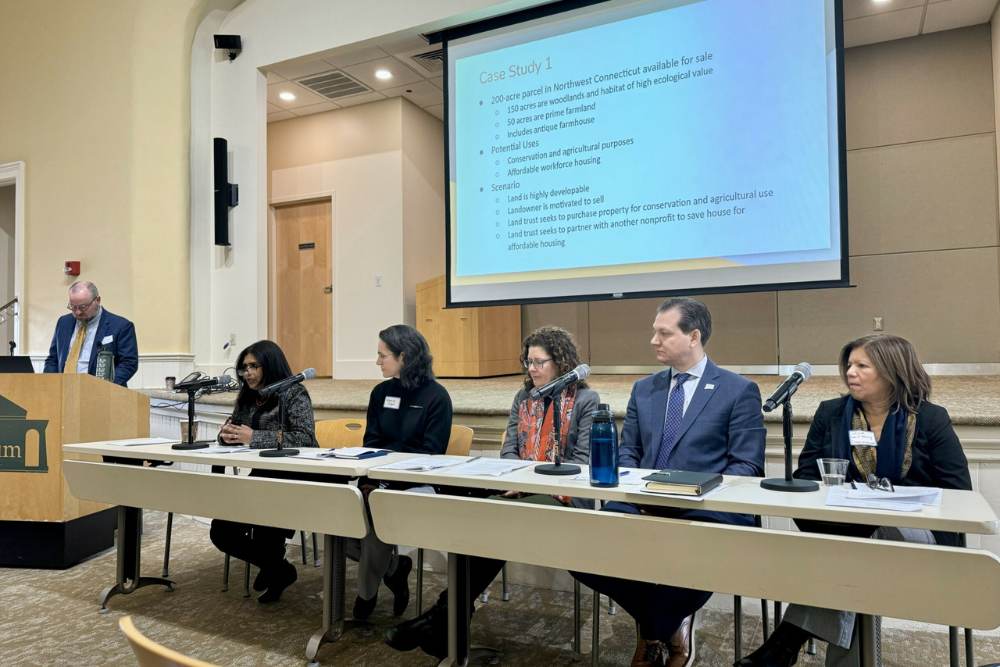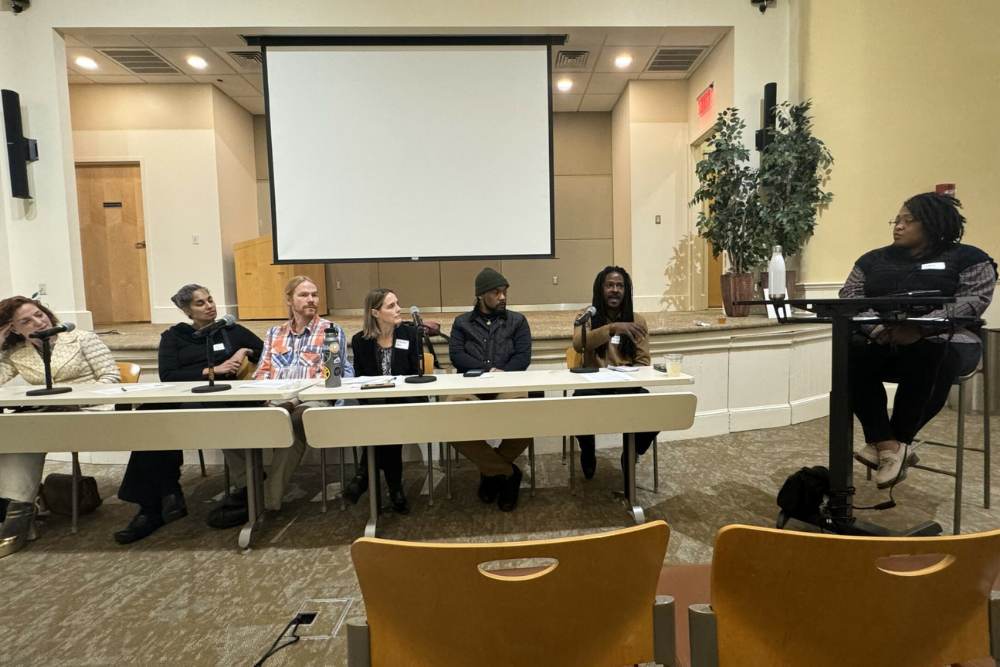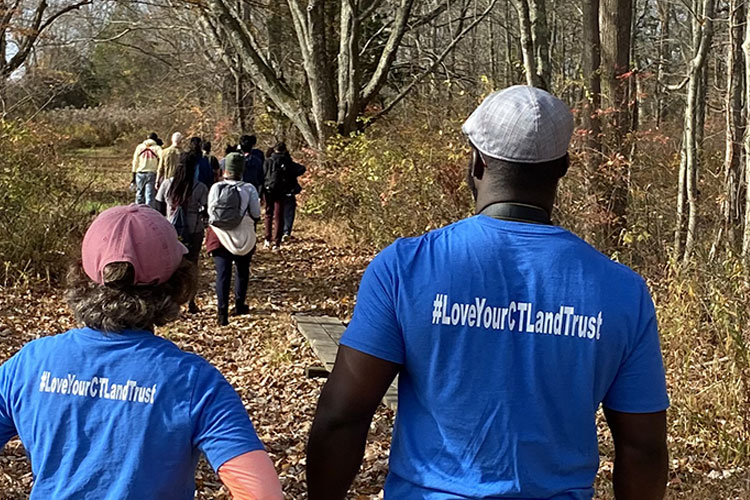News

CLCC recently hosted our 3rd Annual Winter Summit, focusing this year’s event on Land Use in Connecticut: Connecting Grasstops to Grassroots. Over the past three years, we have used these summits to provide a platform for a single specific topic for land trusts over a full-day conference-style event. Previous summits addressed climate change as well as the intersection of affordable housing and land conservation. The 2024 Summit on Land Use in Connecticut had over 100 participants register, with almost as many in attendance despite inclement weather in the morning.
Setting the Stage
The program offered a unique stage for state, regional, and local leaders to look at land use more holistically across agencies and sectors. The conversation provided insights into present and future opportunities for more strategic land use planning and policies in Connecticut. After a break in the day, representatives from regional and municipal stakeholders built on the Grasstops conversation. They discussed the nuances of land use at the local and regional level, navigating state programs and policies, and where opportunities lie to amplify community goals.
The “Grasstops”

(From left) Moderator John Guszkowski and Grasstops Panelists: Director Binu Chandy, Coordinator Rebecca Augur, Commissioner Katie Dykes, Commissioner Bryan Hurlburt, Commissioner Seila Mosquera-Bruno
This first panel of leaders from Connecticut State Agencies, the “Grasstops”, shared ideas and insights about state programs that can be coordinated to incentivize collaborative opportunities for land conservation, affordable housing, farmland access, remediation, and development across Connecticut communities.
The Grasstops panel was comprised of Commissioner Katie Dykes of the Department of Energy and Environmental Protection, Commissioner Bryan Hurlburt of the Department of Agriculture, and Commissioner Seila Mosquera-Bruno of the Department of Housing. Also participating were Binu Chandy, Director of the Office of Brownfield Remediation & Development for the Department of Economic and Community Development, and Responsible Growth Coordinator Rebecca Augur of the Office of Policy and Management.
It was an honor to have these high-profile officials accept our invitation to participate in this conversation, moderated by John Guszkowski, Co-Founder & Principal of Tyche Planning & Policy Group.
A series of hypothetical case studies stimulated discussion between these different agencies. For example:
“A 200-acre parcel in Northwest Connecticut, including 150 acres of woodlands and habitat of high ecological value, 50 acres of prime farmland, and an antique farmhouse, comes on the market. A land trust would like to purchase the property for conservation and agricultural purposes and partner with another nonprofit to save the house for affordable workforce housing. The property is listed with a real estate agent, the landowner is a family entity motivated to sell, and the land is highly developable.”
Reacting to the broad range of goals a case scenario such as this has, the officials discussed grant programs and funding avenues available that could assist in achieving them. Each official offered specific suggestions of programs provided by their agencies that land trusts and their communities may look into when evaluating multiple uses for the land.
The “Grassroots”

(From left) Grassroots Panelists: Tyra Penn-Gesek, Mirna Martinez, Francis Pickering, Connie Manes, Kaleb Garrett, Jonathon Savage, and Moderator Ashley Stewart
The “Grassroots” panelists represented regional and local government entities, non-profits, and community organizations, all tackling new projects and the current and potential relationships that form when land is available. We, again, had the honor of hosting the following invitees, who represent a diverse spectrum of regional and local stakeholders in Connecticut, moderated by Ashley Stewart, Owner of Stewart Environmental and Equity Consulting:
Kaleb Garrett, Founder of The Circle; Connie Manes, Director of the Litchfield Hills Greenprint Collaborative; Mirna Martinez, Executive Director of the Southeastern Connecticut Community Land Trust; Tyra Penn-Gesek, Director of Planning & Development for the Town of Thompson, CT; Francis Pickering, Executive Director of the Western Connecticut Council of Governments; and Jonathon Savage, Interim Executive Director for Gather New Haven.
Reacting to the points made by their Grasstop counterparts, these panelists engaged the audience to view how we utilize the land through their ever-evolving working perspectives, which include understanding the funding sources, policies, regulations, codes, and alignments that apply to their field of work while also keeping focus on their mission. A task many of us in the land trust community can well relate to.
The diversity of perspectives offered by the panelists and their specific points of view pushed the conversation forward. The audience was engaged with both sessions, and we collected their questions and takeaways that time didn’t allow for. We will forward these to both panels, and their responses will be synthesized into a list of resources that we will publish.
Takeaways

Connecting these two panels – I think about our summit tagline, “Grasstops to Grassroots”. A single blade of grass must be tall enough to get the sun necessary to produce energy. It also needs strong roots to stabilize itself and to establish a rich network to retrieve as many nutrients in the soil as possible. If either of these two parts are weakened, the plant will suffer.
The State of Connecticut is not very large, but it is dense. There are many blades of grass. Our state agencies “reach up” to the federal level and collect resources to aid and transform the efforts on the ground. Those who work more locally gather as much information and resources as possible to support their projects and establish a strong network whose successes and challenges can be used as leverage to advocate for more assistance.
The challenge of building community is knowing how to hear every voice in the room and unite them toward common ground and understanding. Our relationship with the land is personal, which means every person has a different perspective on what that relationship looks like. These Annual Summits provide a forum for multiple voices to convene and reveal that ground.
Audience members had a chance at the end of the day to share their opinions and takeaways in an open forum. Many were interested in possible methods for capacity building and policy updates that could promote more cross-collaboration and flexible solutions, as well as how the connection from the “Top” to the “Roots” can be better facilitated.
Intriguing ideas that were explored included building on DEEP’s concierge service to allow for enhanced intra- and inter-agency review and input on land use projects, with a point-person within the agency who assists in directing people to the relevant avenues. Organizing a group to apply jointly for funding, such as an affordable housing group and a land trust interested in the same piece of land, was another method encouraged by officials.
Next Steps
CLCC is committed to encouraging more of these discussions so that the connections between the state agencies and local stakeholders become stronger, more transparent, and more holistically aligned. So that the connection between the people of Connecticut and its land is as well, we are using our unique position as a statewide organization that focuses on these local and regional stakeholders to help foster these connections through our Community Conservation programming.
As stated above, we have compiled audience questions and are forwarding them to panelists from both discussions for comment and responses. To further promote communication between the two groups, we aim to follow up with a joint roundtable meeting between these agencies and regional/local stakeholders at a later date. We will also publicize these into a list of resources.
Video Recordings of both panel discussions can be viewed here on our YouTube Channel:
I look forward to seeing what voices next year’s summit brings together and hope more conversations like these are had across the public and private sectors and within state agency hallways.
![types] types]](https://ctconservation.org/wp-content/uploads/Jovan-Bryan-Headshot.jpg)
Tags: Summit, Summit on Land Use

